Proposal for an Opera House
In 1905, plans were drawn up for an Opera House at ‘Plough Corner’, the junction of Leigh Road and West Road, in Westcliff, named after the Plough public house, which still stands, next to the theatre. (By mid-1920, Leigh Road had been renamed London Road. It is the main A13 trunk road between London and Southend, while West Road connects Westcliff to the former hamlet of Prittlewell.)
Construction Starts – then Halts
Construction started in 1907 by local builder Richard Piper, but, for reasons which have not been determined, this stopped with only the lower part of the façade having been built. However, after a short period, a saviour arrived in the figure of Matt Raymond, proprietor of the Raymond Animated Picture Company.
Matt Raymond and The Raymond Animated Picture Company
 Matt Raymond was born in 1874. While working as an electrician at London’s Royal Polytechnic Institution, he overcame the serious technical problems that showman Felicien Trewey was experiencing in installing the Cinematograph Lumiere. As a result, Trewey engaged him to set up other Lumiere shows, and he might well have shot the first English Lumiere films. After installing a Chard & Co. projector at the Shakespeare Theatre, Liverpool, for showing films during the pantomime Babes in the Wood in 1896, Raymond joined Maguire & Baucus, selling Edison projectors. In 1898 he toured with a Warwick bioscope, eventually installing these machines in music halls in several European countries.
Matt Raymond was born in 1874. While working as an electrician at London’s Royal Polytechnic Institution, he overcame the serious technical problems that showman Felicien Trewey was experiencing in installing the Cinematograph Lumiere. As a result, Trewey engaged him to set up other Lumiere shows, and he might well have shot the first English Lumiere films. After installing a Chard & Co. projector at the Shakespeare Theatre, Liverpool, for showing films during the pantomime Babes in the Wood in 1896, Raymond joined Maguire & Baucus, selling Edison projectors. In 1898 he toured with a Warwick bioscope, eventually installing these machines in music halls in several European countries.
He served as Treasurer of the Cinema Trade Protection Society (1907-1920) and later the Cinematograph Exhibitors’ Association. From 1921 he was master of the ‘Anima’ masonic lodge for film industry members. He died in 1941.
He founded the Raymond Animated Picture Company in 1905. By the time he turned his attention to Westcliff, he, and his business partner, Matthew Feakes, had built up a circuit of some 17 theatres, in places including Walthamstow, Hoxton and Harrow Road (in London) and Egremont (Cheshire), Grimsby and Sheffield, most of which (if not all) had facilities for showing moving pictures. (The Raymond Animated Picture Company ceased trading in 1925.)
In April 1912 his architect, Edward John Ward, drew up revised plans for the New Palace Theatre, as variety replaced the somewhat loftier ambitions of an Opera House.
In August, at Southend Borough Petty Sessions, licences were applied for with regards to stage plays and “public dancing, singing and music or other public entertainment”. The hearing was attended by “a large body of Free Church people” and a representative of the Salvation Army. Their concerns were two-fold: whether the applicant would be applying for a liquor licence and whether the performance licence would be for six or seven days. Assuaging these concerns, Mr Feakes said he had no intention of seeking a liquor licence, and was only requesting a six day performance licence. His applications were duly granted.

Architects drawings for the Opera House (left), and for the Palace Theatre (right)
Opening of the Palace Theatre
The New Palace Theatre duly opened on Monday 21st October 1912, offering “Cinema & Vaudeville: The Best of Both”. By the standards of the day, it was said to be “a most modern building of a unique design”, claiming to be the only building of its time to be fitted so that “no matter from what part of the building spectators look up to the stage, there is a clear and uninterrupted view”. It seated 1,200 patrons, plus 300 standing (compared to 603 all-seated today!) and was under the day to day management of Matthew Feakes, one of Mr Raymond’s senior directors.

Postcard of the Palace Theatre with opening announcement
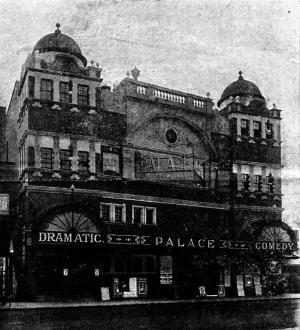
Scanned photograph from an April 1914 programme cover. (Courtesy of Chris Looker.)
The “Vaudeville” turns were the usual eclectic mix, and included ‘The Great Ramses’, The Six Puritan Maids, Simosa San and her “Highly Trained Performing Pigeons”, The Boy Kosky and Reolgin’s Performing Parrots! “Cinema” made an appearance on the bills, mostly notably and poignantly with An Ocean Catastrophe, inspired by the loss of the Titanic just six months earlier.

Fragments of the past: At fly floor level, high above the stage, these posters from 1913, tattered but unbowed, survive to this day.
Among other attractions was ‘The Grand Amateur Carnival’’, a forerunner of today’s ‘Britain’s Got Talent’, but, perhaps surprisingly, variety didn’t last long, and by May 1913 a “Dramatic Season” was being announced. Since then, apart from one-night shows and a period of about six months from 1934-35, plays have been the main offering.

Note “The Call of Duty”, which preceded the show, in this advert from August 1914

Newspaper adverts: Left: April 1915 / Right: November 1916 (Note the reference to War Tax)
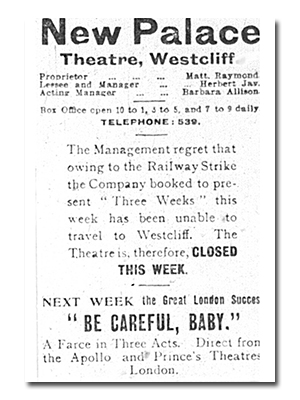
September 1919: A rail strike led to the cancellation of the play Three Weeks
Rare Survivors from those days of Variety
These Numbers Boards, or Act Number Indicators, set into both sides of the proscenium arch, date back to those early days of the Palace theatre. They are also thought to be quite rare nowadays.

As their names suggest, they displayed the numbers of each variety act. This would help anyone arriving during the show, or who had not been paying sufficient attention, to check with their programme which act was currently performing.
This still from the 1943 film The Dummy Talks, kindly provided by Jim Laws, of Jim Laws Lighting, shows a Numbers Board in action.

Although ‘our’ boards haven’t been used for their original purpose since 1913, they are thought to have been used to warn of air raids during the Second World War and then, after the war, in rather calmer times, they were used to advertise afternoon teas! Clearly the original lighting could not have been used for these purposes – and had anyway, presumably, been removed and/or disconnected – so lighting specialist Jim Laws suggests that ‘gobo’ lights would have been used to project the wording onto the boards.
And, even in their disused state today, these Numbers Boards are fascinating survivors from the Golden Age of Variety!
Under New Ownership
In 1918, Herbert Jay replaced Matthew Feakes as manager. Mr Jay was an actor who had his own company, and in December 1919 he purchased the theatre for £11,600. Whether he was aware that a certain lady also had an eye on the theatre is not known, but, just a few months later, he sold it, for £25,000 and a substantial profit, to the most important person in this story.
Gertrude Mouillot
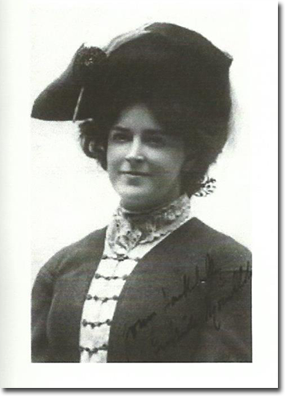
This formidable lady was the widow of Frederick Mouillot, a wealthy theatrical entrepreneur who, in August 1911, had died of a sudden heart attack, at only forty-seven years of age. Gertrude inherited Frederick’s business interests, which apparently included 15 theatres; once an actress, she never acted again. But quite why she bought the Palace is unclear; she is not known to have any connections to the area. It is also unclear when she divested herself of the other theatres – perhaps their sale allowed her to acquire the Palace.

Week commencing Monday 12th April 1920: Gertrude’s first show. (Scan from newspaper.)
The Mouillot Years
In the event, Gertrude ran the Palace for what must have been a very interesting 20 years or so, with, undoubtedly, a number of ups and downs. At some stage the bioscope ‘lantern room’ (projection box) was moved from the rear of the stalls, where it occupied valuable front-of-house space, to an alcove that was built into the rear of the stage wall (and is still there to this day), so the occasional film presentations were shown through a translucent screen using ‘rear projection’.
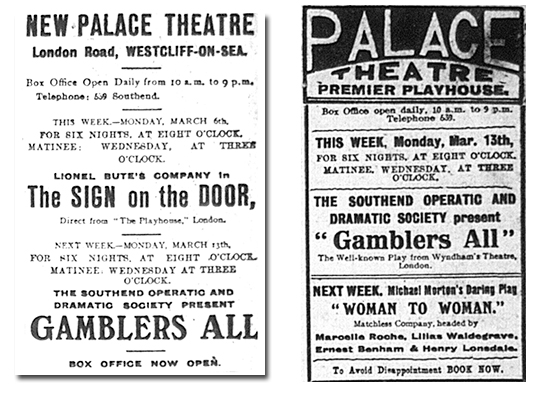
March 1921: The New Palace becomes the Palace

Making up London Road at Plough Corner in 1922, with the Plough public house to the left of the Palace Theatre (Courtesy of Bob Dalgarno)
Gertrude does appear to have taken the theatre ‘up market’, with many top names of the day – including Ivor Novello, Mrs. Patrick Campbell, John Clements, Ruth Draper and Sybil Thorndike – performing at the Palace.

Programmes dated 1924 (left) and 1935 (right)
The Palace Cinema
For a brief period from October 1932 to March 1933 the Palace was a full-time cinema. Gertrude might have tried this due to declining (live) theatre business or a desire to become part of the cinema revolution heralded by the introduction of ‘the Talkies’, or a combination of both. (Indeed, in June 1932 a music and dancing licence had been granted by Southend Justices following an application by Mr P. M. Selby, the general manager, who said that times were difficult, but this request did not mean a change in the theatre’s overall policy.)
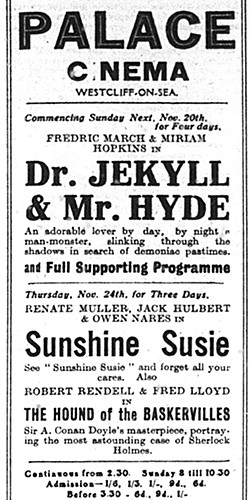
However, full-time cinema did not last long and the theatre soon reverted to stage shows.

Vaudeview in July 1934 and Dracula in October 1936
Albeit not without continuing difficulties, as this rather desperate advert from October 1935 indicates!

The End of the Mouillot Years
Fearful of bombing raids, the Government closed all places of entertainment following the outbreak of the Second World War. However, the adverse effect this had on the nation’s morale overcame these fears, and the Palace reopened on Monday 18th September 1939 with Goodness, How Sad! However, this atmosphere of ‘business as usual’ only lasted until the weekly run of Hay Fever from Monday 30th October.

As can be seen from this newspaper report, the intention was that the Palace would close “for the duration” (“Mr. Phillips” being Eric Phillips, who had presented plays at the theatre since April 1939.)
However, the Palace reopened on Boxing Day 1939, now under the management of the Regal Theatre in Tyler’s Avenue, Southend-on-Sea (which, perhaps not coincidentally, had been managed by Herbert Jay in 1921).

Dick Whittington was followed by Cinderella and a week of variety before, following a month long closure and the departure of the Regal management, the Palace reopened in February 1940 with the rather more highbrow Les Ballet des Trois Arts, which presented ballet highlights until April .
Thereafter the Palace struggled on with a series of weekly plays. Finally, after a week’s run of the perhaps appropriately titled On the Spot (which ended on Saturday 1st June 1940), the Palace – and Gertrude – bowed out in spectacular style the following day. In what must have been quite a coup, the much-loved entertainer Tommy Trinder topped the bill at a spectacular Gala Concert in aid of the Red Cross Society and St. John’s Ambulance.

Then, in an almost unprecedented gesture, in September 1942 Gertrude offered the Palace as a gift to the Borough. The Council accepted her offer, which included the stipulation that it “be held by the Council for any purpose which they might decide for the social benefit of the borough, but the property is not to be sold”.

This plaque, proudly displayed above the entrance to the stalls, commemorates Gertrude Mouillot’s remarkable generosity
The Council Takes Control
The conveyance of the property to the Council was completed on 31st December 1942. The Council initially said that no money would be forthcoming for necessary repairs, etc until after the duration. However, money was eventually found, as the Palace reopened on Monday 22nd May 1944 with Noel Coward’s Blithe Spirit.


Palace Theatre August 1949
Thereafter, Harry Hanson’s Court Players were engaged to present plays in repertory. Their first was Quiet Wedding, in June 1944, and they continued until their final production, Spring Model, in November 1954.

Court Players newspaper adverts from March 1945 and February 1947

Real-life drama in February 1947: The Show Must Go On!

This lovely photograph was kindly donated by Chris Hebden. It is endorsed on the back “Yeomen of the Guard, November 1948”, and shows the backstage team that worked on that show, presented by the College Dramatic Society.
Unfortunately, only some of the crew have been identified:
Back row: At left: Charlie Woods (Backstage doorman) / At right: Arthur Minguard
Middle row: At left: Chris Hebden (Chris’s grandfather) / Second from left: Tom Murphy / Fifth from left: Len Starr / Fourth from right: Gordon (Steve) Leak / Second from right: Don Hebden (Chris’s father)
Front row: At right: Andy Faulkner (fireman) / Second from right: Jack Starr
Chris was named after his grandfather. He was born in 1887; in his later years he was a tram driver, and secretary of the local branch of the Transport & General Workers Union until his retirement.
Chris’s father, Don, born in 1921, was a lab technician at Southend Hospital, then a mechanic at Westcliff Motor Company before becoming Chief Electrician/Stage Manager at the Palace theatre. He had started at the Palace circa 1948 in a part-time capacity, before becoming full-time in about 1963. He left in June 1969 and was a member of the duty crew at Southend Transport until his retirement.
Chris worked at the Palace from 1963/64 until the early 1970s. He worked backstage, and front of house “on the limes” (spotlights). He also provided cover as Stage Manager while his father was off sick.
If anyone can identify any of the other members of the crew please contact our archivist.

In March 1955 acclaimed actor A. E. Matthews appeared in The Manor of Northstead. He was 85 years of age, and his long contribution to the stage was commemorated , ‘Hollywood-style’, with hand and foot impressions in an inscribed cement block. Today that block is on display on the theatre’s front wall.

After a year and a half when shows were put on by a number of groups, the Palace closed in May 1956 for one week prior to a grand re-opening with the theatre’s own Palace Players, ‘Southend’s New Civic Repertory Company’.
The Palace Players began with the splendidly titled Hippo Dancing and ended in November 1959 with The Magic Cupboard. In January 1960 it was the turn of the Arthur Brough Players, who started with The Shadow Between and ended in November 1961 with Murder at the Vicarage.
From June to November 1962 the Peter Haddon Company presented weekly rep, from May 1963 to November 1964 it was the turn of Audrey Lupton and Arthur Lane’s Ayell Productions, while, from April 1965 to June 1969 Alexander Bridge’s Haymarket Stage Productions took over.

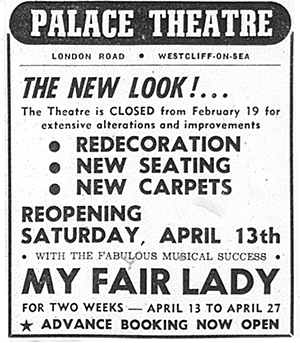
Spring 1968: A major refurbishment
However, these companies did not have exclusive control. Other professional companies presented ‘one off’ engagements, and the very healthy amateur scene was well represented (as it still is to this day) by the likes of Southend Drama Society, Leigh Operatic and Dramatic Society, Southend-on-Sea Operatic and Dramatic Society, Southend Shakespeare Company and Westcliff Amateur Operatic and Dramatic Society.

In a coup for the Palace, Peter Adamson (well-known on TV as Coronation Street‘s Len Fairclough) starred in A Thousand Clowns in August 1973
Palace Theatre Club
Back in 1957 the Palace Theatre Club had been formed, dedicated ‘to encourage interest in all aspects of living theatre and, in particular, the Palace Theatre’. The Club thrives to this day and, through its fundraising, is able to make a very tangible contribution to the theatre.
Closure and Protest
Not for the first time, money troubles plagued the Palace and, after the appropriately titled The Last Laugh had ended its weekly run on Saturday 5th July 1969 Alexander Bridge departed and the theatre closed.

The Palace Theatre Club swiftly swung into action, mobilising public opinion and gathering signatures on a petition. A protest march, with banners proudly flying, made its way up Hamlet Court Road, into London Road and on to the Palace. This was led by Councillor Beryl Scholfield, later to become mayor of Southend. There was no mistaking the public mood, and the Council responded positively by setting up the Palace Theatre Trust, a charitable body that would manage the theatre.
Ray Cooney Steps In
Applications were invited for an artistic director. Farce specialist Ray Cooney had close family ties to Westcliff (his grandmother lived there and his parents later retired there) so he knew the Palace very well. Dismayed to hear it had closed, he applied for the position of artistic director despite having seven plays in the West End! But this was a labour of love and, so long as the Council was prepared to offer a subsidy, he was prepared to take it on. So it was that Ray Cooney Productions presented fortnightly rep, starting with Spider’s Web on Monday 15th September 1969.

Programmes from 1969
Unfortunately, the small matter of finance reared its ugly head once more, and Ray Cooney soon discovered that it was virtually impossible to make any sort of decent living from a 600 seat theatre. He had been quite happy to invest in the Palace, and give the venerable old theatre another lease of life, but a year later, in September 1970, he presented his final production, Plaza Suite, and the Palace closed yet again.
A New Direction: Tony Clayton and The Palace Theatre Company
 Under the guiding hand of the Palace Theatre Trust, Tony Clayton was appointed artistic director, charged with providing repertory productions using the in-house Palace Theatre Company. His first was The Prime of Miss Jean Brodie in October 1970, and an early coup saw him entice Dame Edith Evans to Westcliff to present her one-woman show Poetry for Pleasure.
Under the guiding hand of the Palace Theatre Trust, Tony Clayton was appointed artistic director, charged with providing repertory productions using the in-house Palace Theatre Company. His first was The Prime of Miss Jean Brodie in October 1970, and an early coup saw him entice Dame Edith Evans to Westcliff to present her one-woman show Poetry for Pleasure.
But money was again a problem. Tony Clayton set up an appeal fund, persuading Noel Coward to become its patron, and arranged many fund-raising activities. But then a bombshell arrived in the shape of a plan to build a multi-million pound office block at Victoria Circus (where the Odeon cinema now stands) – which would have a theatre in the basement that would replace the Palace. With some councillors, and also some members of The Palace Theatre Trust, in favour of this scheme, and growing increasingly tired of the constant battles, Tony Clayton decided he’d had enough. His final production, Bell, Book and Candle, was presented in November 1972. He was, however, invited to look through the applications for his replacement, and he recommended that Leslie Lawton be appointed.

The Palace in January 1972, showing the shop next door (with the semi-circular roof pediment) that would be demolished in 1981 to make way for the bar/foyer extension and Dixon Studio.
Leslie Lawton: Artistic Director
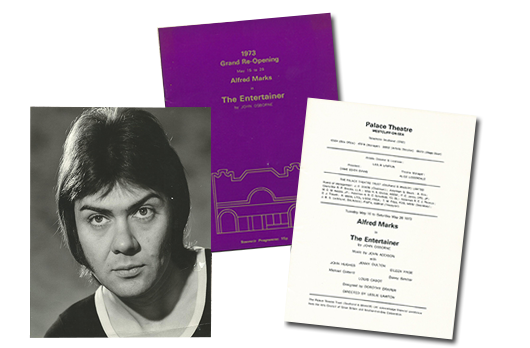
A regular on TV and in the West End, Leslie had been given his first chance to direct by Arthur Brough and he was intrigued by the thought of fortnightly rep. After a few shows Leslie helped give the theatre a bit of a sprucing up and held a Grand Re-Opening in May 1973 with Alfred Marks in The Entertainer. There is lovely story of Leslie telling the cast to carry on their final rehearsal without him – as he had to go into the foyer to staple down the new carpet – only to find Alfred Marks joining him, vacuuming the carpet! Leslie knew Dora Bryan, who had, coincidently, started her career at the Palace in July 1944 with Harry Hanson’s Court Players, and in November 1973 she brought her show An Evening with Dora Bryan and Friends to the Palace. Never wanting to ‘play it safe’, Leslie presented challenging productions such as many Shakespeare plays and the gay themed The Boys in the Band. He also enticed local legend Peggy Mount to the Palace on many occasions. But he, too, was tiring – the tight budget meant he had to either direct or act in pretty much everything- and when he was offered Liverpool Playhouse (and with it more money) he decided to move on. He went out in style, in June 1975, with The Bandwagon, starring Peggy Mount.
Grade II Listing
The special architectural importance of the Palace Theatre was officially recognised on 23 August 1974, when the theatre was granted Grade II listed status.
The listing description describes the Palace as “a small theatre built in 1912 with ornamented exterior façade and interior which is a good example of its period. The front façade bears the date 1912. The façade is of red brick with stucco dressings and ornamentation. A large central semi-circular arch with a stucco ornamented bulls eye window in the tympanum and surmounted by a ballustraded parapet with side scrolls is flanked by towers with stucco cornices and ornamentation and “Dutch” gables to the parapets, with ball finials. The ground storey has two side doorways with semi-circular arched heads and stucco cartouche in the tympanum. The interior has two curved balconies with paired side boxes with semi-circular fronts and domed recesses. The balconies and boxes are ornamented with stucco cartouche. The ceiling and proscenium arch are panelled, with stucco ornamentation.”
It is also worth noting that the panels, at either side of the proscenium, used to display the number of each variety act in the theatre’s early years, are particularly rare survivors.
Christopher Dunham: Artistic Director

Three faces of Chris Dunham: His ‘debut’ at the Palace Theatre in March 1975, in August 1980 and in March 1997.
(Photographs © Echo Newspaper Group (courtesy of Rayleigh Town Museum))
Chris had known Leslie Lawton some time, and had directed some plays for him at the Palace. So when Leslie left Chris applied for the role of artistic director and was accepted, his first major change being from fortnightly to three weekly rep. Chris’ first show, in June 1975, was the farce See How They Run.

Southend Carnival 1981: A typically saucy title is advertised on the theatre’s float! (Scan from newspaper)
Construction of the Dixon Studio
In 1980 the lease came up on the council owned buildings to the west of the Palace. The opportunity was taken to replace them with a two-storey extension, with an enlarged bar and foyer on the ground floor (and an open courtyard, now an enclosed foyer extension) and a 100-seat Studio Theatre cum Rehearsal Room on the first floor. Facilities in the theatre itself were improved by the enlargement of the box office, actors’ green room, scenery store and wardrobe. The £315,000 contract was won by Whitgift Construction, of Brentwood, with £100,000 being raised by popular appeal by the Palace Theatre Trust, £50,000 from the Arts Council of Great Britain and the balance from the council.
The Palace Theatre Trust appeal was led by the late John Dixon, who owned Dixons department store. Below is just one of the programme exhortations in aid of the appeal.
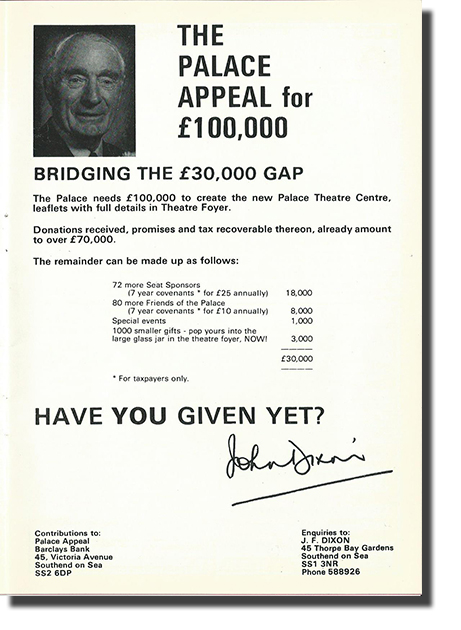

The Palace Theatre Centre
The newly christened Palace Theatre Centre opened on Thursday 27th May 1982 with Cabaret in the main auditorium.
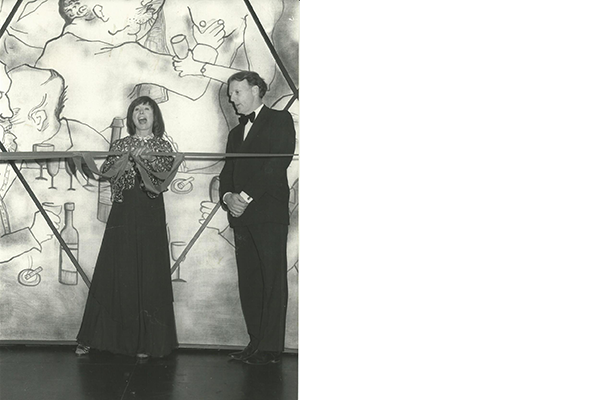
Westcliff-born actress Anne Stallybrass, a regular performer and member of the theatre appeal committee, cuts the tape to open the Palace Theatre Centre
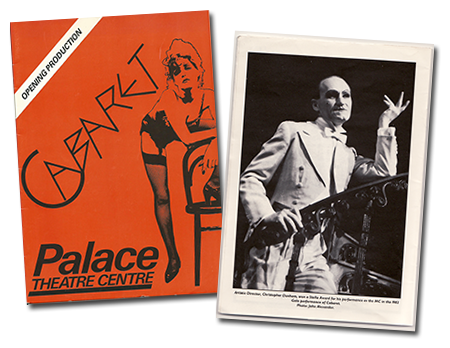
Artistic Director Christopher Dunham as the M.C. in Cabaret
In the end, the Palace Theatre Trust raised more than its required £100,000, a wonderful achievement. John Dixon’s huge contribution to the effort was immortalised when the Studio Theatre was named in his honour.
The Dixon Studio opened in September 1982 with Duet for One. These photographs, showing just four configurations, illustrate its versatility. It has proved to be an incredibly valuable addition to the theatre’s facilities.


John Thaw (TV’s The Sweeney and Inspector Morse) outside the Palace while starring in Staircase in August 1985. Also pictured, his daughter Abigail, who appeared in Whipping It Up in September 2007.

Summer 1991: A typically varied ‘Palace Pot Pourri’

Southend Carnival float advertising the forthcoming 1991 Christmas show. With the float, at left, Marion Orchard, Marketing Manager, at the back, David Copperwaite, House Manager and, at right, Paddi Cole, Administration Assistant
In the early 1990s, Marketing Manager Marion Orchard created photo opportunities by taking actors ‘out and about’ in the local area. Here are just some of the locations used:

Southchurch Hall (Liz Bagley and Robert Morris, Rebecca, April 1990)

Southend Civic Centre (Simon Corris, Brian Tully, Peter Carr, David Birrell and Michael Bottle, Beyond Reasonable Doubt, October 1990)
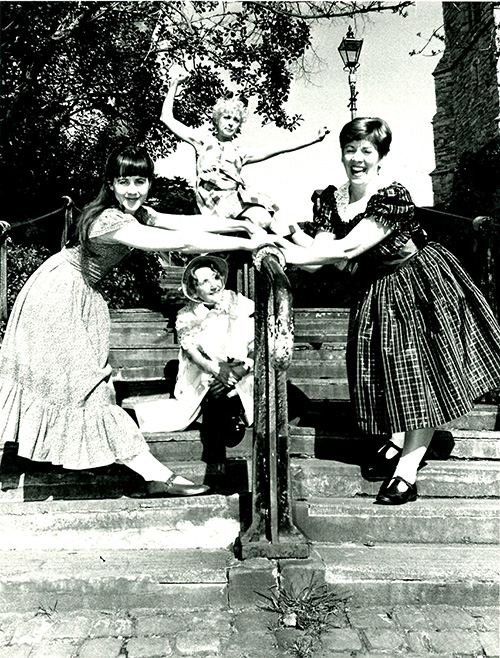
Church Hill steps (by St. Clements) Leigh (Vicky Blake, Gabrielle Hamilton, Wendy Morgan and Helen Fraser, My Mother Said I Never Should, March 1993)

Southend Airport (John Pythion, Eileen Bell and Darren Machin, Straight & Narrow, July 1994)

Westcliff High School for Boys (‘Headmaster’ Peter Laird, Forty Years On, November 1994)
(Photographs © Echo Newspaper Group (courtesy of Rayleigh Town Museum))

1996: Palace Theatre and bistro
(Exterior photograph © Echo Newspaper Group (courtesy of Rayleigh Town Museum))

Agatha Christie murder mysteries have made regular appearances at the Palace. These programmes are from 1993 (Murder at the Vicarage) and 1994 (Black Coffee), while And Then There Were None was included in this line-up from 1995. They remain perennial favourites, with Robert Powell appearing as Hercule Poirot, in Black Coffee, as recently as March 2014.

Leda and the Swan
In Greek mythology, the god Zeus transformed himself into a swan in order to have his way with the nymph Leda. In 1973 Southend Council commissioned Surrey artist Lucette Cartwright to reproduce this in a £3,000 bronzed glass fibre sculpture.
It must have seemed a good idea at the time but, when this rather frank depiction of seduction (at best) and rape (at worst) was unveiled in 1974 outside the Civic Centre it was soon dubbed ‘The Dirty Duck’. More seriously, complaints came in from female members of staff who objected to being faced with this heavy phallic symbolism as they arrived for work, and it was soon moved out of sight.
The Council at first intended to sell it, but then decided to give it away. Never one to shy away from controversy, Chris Dunham jumped at the chance to add this controversial statue to the courtyard at the Palace Theatre.

It was moved to its new home in May 1988. However, in January 2000, when the courtyard was enclosed to create a larger bar seating area, the statue was returned to the council. It was rather unceremoniously deposited, well out of the way, at the bottom of the garden behind Porters Civic House & Mayor’s Parlour, in Southchurch Road, where it resides to this day.
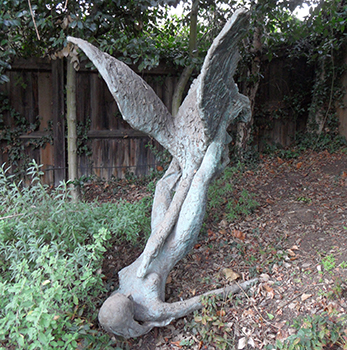
The Palace reaches 80
In October 1992 the Palace reached its 80th birthday. A special play, Time Windows, was commissioned and, during its run, on the momentous day, Wednesday 21st October, this milestone was celebrated with a pre-show reception and birthday cake. (See Palace Theatre Club)
To provide a more lasting commemoration Judy Reaves, the theatre’s resident set designer, repainted the 30ft by 20ft safety curtain in splendid style to reflect the theatre’s Edwardian origins. A book on art nouveau provided the inspiration, and the two elegant ladies in the design have become a regular motif. The design also proudly includes the theatre’s year of opening. (The ‘before’ photograph is from 1987.)

The End of the Chris Dunham Era
Chris has always said he should have left after 20 years, not stayed for another four. Constant battles for grants from Eastern Arts, which much preferred to give its funding to other theatres, and pressure from a majority on the Board of the Palace Theatre Trust, who appeared to have on their agenda the closure of the Palace, took their toll. He received tremendous support from Albert Reddihough, chairman of the Board of the Palace Theatre Trust (and owner of Southend-based KeyMed, suppliers of medical equipment), who took the Palace’s case to Lord Palumbo at the Arts Council, but all to no avail. In March 1999, without significant financial support, the Palace was forced to close. Chris and all 40 members of staff were made redundant.

The Green and Lenagan Period
Julius Green and Ian Lenagan had produced some West End plays and a number of tours. Hearing that the Council was looking for a company take a lease on the Palace, they paid a visit and, like so many others, fell in love with it.
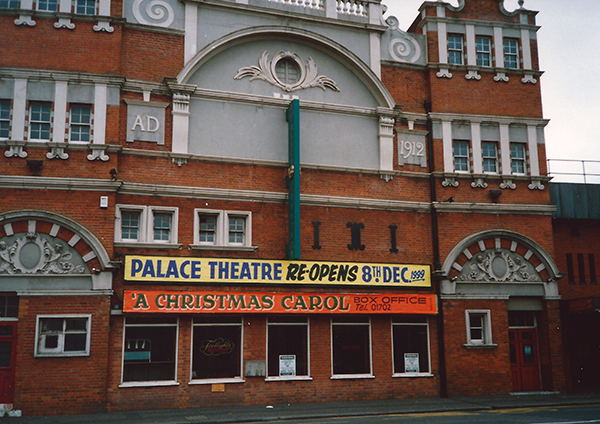
Wonderful news! The Palace set to re-open on 8th December 1999
Enter Roy Marsden
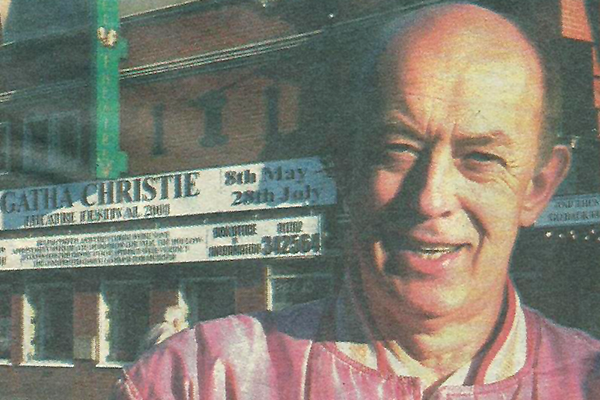
Roy Marsden, well known for portraying Adam Dalgleish in the TV series based on the PD James novels, was engaged as artistic director. He knew Westcliff well, as his grandparents lived there and his wife and her family came from neighbouring Chalkwell. The Green and Lenagan era opened in December 1999 with A Christmas Carol (they were not allowed to put on a pantomime, as it would clash with the Cliffs Pavilion). Roy headed the Palace Theatre Repertory Company and was to direct at least five in-house productions a year, in addition to a lively mix of visiting companies, local amateur societies, ‘one nighters’ and Sunday concerts. As before, the theatre often hosted local bands on Sunday nights. Undoubtedly their greatest achievement was The Agatha Christie Festival in 2001, which featured all of the writer’s works, including a Sunday-only performance of The Mousetrap by the London cast.
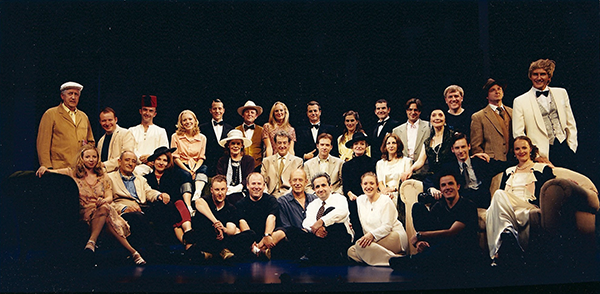
The Agatha Christie Festival cast, with Roy Marsden (centre front, in light blue shirt).

The End of the Green and Lenagan Era
Despite entering into an agreement with the Palace Theatre Trust for five years, Green and Lenagan, like others before them, found the finances involved with a theatre with only 600 seats very difficult. Once again, Eastern Arts refused to assist, so, after just two and a half years, in June 2002, Green and Lenagan left and the theatre closed.
Under New Management
In April 2003 the Palace re-opened under joint management with the Cliffs Pavilion as a receiving house in tandem with the Cliffs. The economics were assisted by combining the box offices and having a flexible workforce, but the Palace’s future was always in doubt and, in October 2005, following a cut in central government funding, the council closed the theatre.
The Fight Was On!
A great deal of public interest and concern was expressed through demonstrations and a petition which attracted over 22,000 signatures. The seminal event was a public meeting at the Palace at which the Palace Theatre Guild was set up. The Guild aimed to raise the public profile of the Palace and secure funding so it could reopen. One of its first fund-raising events was a seasonal production of A Christmas Carol at Crowstone Church, Westcliff. In response, the council offered the Palace and the Cliffs for private tender.

Campaign leaflet issued by local newspaper ‘The Yellow Advertiser’
Enter HQ Theatres
There were originally five bidders. Two of these, theatre operator Heatherington Seelig and QDOS Entertainment, which specialised in pantomimes, joined forces to set up HQ Theatres and took over the running of the Cliffs Pavilion and the Palace in December 2006. The venues are now collectively known as Southend Theatres, and the Palace can do what it does best: present a wide variety of very popular shows – from serious drama to comedy and musicals as well as a number of successful ‘one nighters’ and amateur shows – to an extremely loyal and appreciative following.
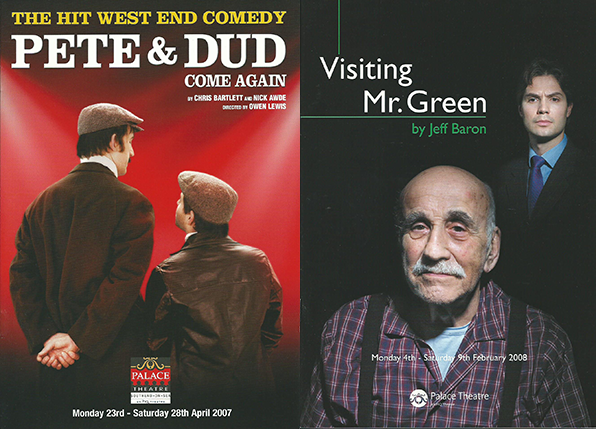
Into the 2000s: A celebration of legendary comedians Peter Cook and Dudley Moore, and Warren Mitchell (Alf Garnett in TV’s Till Death Us Do Part) comes to the Palace
Centenary 2012
It was therefore with a great deal of optimism that staff and supporters celebrated the Palace’s 100th birthday in grand style! Find out more about our Centenary activities.
Tales from the Palace Theatre
As a final act before being dissolved, the Palace Theatre Guild financed a celebratory book, Tales from the Palace Theatre, which tells the full story of the first 100 years of this remarkable theatre, with contributions from many of the people mentioned in this narrative.
A splendid refurbishment
As a final centenary gift, the Council, HQ Theatres and the Palace Theatre Club pooled their resources and, in early January 2013, the stalls seats and carpets were replaced, repairs were made to damaged seats in the circle and the dressing rooms and backstage areas were redecorated and refurbished. This lovely old theatre had never looked better!
A Royal visit
The refurbishment was well timed, as history was made on Wednesday 29th January 2014, when Their Royal Highnesses The Prince of Wales and The Duchess of Cornwall became, so far as is known, the first members of the Royal Family to visit the theatre.
The occasion was a Gala performance by the Shakespeare Schools Festival to launch its 15th year and the 450th anniversary of the Bard’s birth. The Royal visitors were greeted by Derek Nicholls, Chairman, HQ Theatres & Hospitality, Ellen McPhillips, Theatre Director, Southend Theatres, and Palace Theatre manager Georgie Perkins, together with many dignitaries, led by mayor Brian Kelly. As befits the Schools Festival, many local schoolchildren were also present, creating a wonderful atmosphere which the Royal guests clearly enjoyed enormously.

After watching several short extracts from Shakespeare’s plays, performed by pupils from a number of schools, Their Royal Highnesses joined the cast on stage to chat about their performances. The Royal visitors were then guided to the Dixon Studio, where they spent time with the dignitaries and invited guests.
The road outside the Palace was crowded with well-wishers for this glorious occasion, eager to catch a glimpse of the Royal couple during this momentous event in the long history of this wonderful theatre.
A further refurbishment
For several months in 2017, the Palace frontage was covered in scaffolding and protective sheeting. Once removed, in late July, the results of the extensive cleaning and redecoration works were clear for all to see. The opportunity was also taken, during a two week closure in late August/early September, to fully refurbish the Gallery, repaint the auditorium ceiling and clean the Boxes. This required an extensive amount of scaffolding, something of a work of art in its own right! Further photographs of this work can be seen in the gallery.
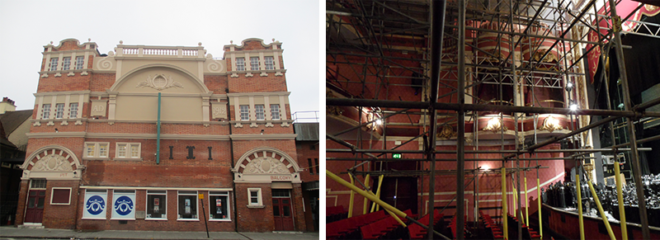
The Palace and COVID-19
In December 2019, in the city of Wuhan, China, a virus was identified that was soon designated SARS-CoV-2 (Severe Acute Respiratory Syndrome Corona Virus 2). This resulted in the extremely rapid worldwide spread of coronavirus disease 2019, commonly known as COVID-19.
On 30th January 2020 the World Health Organization declared a Public Health Emergency of International Concern. A pandemic was declared on 11th March.
The disease had reached the UK in January. In response to the declaration that this was officially a pandemic, at 8.30pm on 23rd March, Boris Johnson, the UK Prime Minister, announced a ‘stay-at-home’ order, effectively locking-down the country.
Aware that this announcement was imminent, and faced with the escalating health crisis, HQ Theatres had already closed the Palace Theatre and the Cliffs Pavilion from Tuesday 17th March.

Closure announcement in the window at the Palace
The final shows, prior to the closure, were Up Close and Personal with the Fizz, a Bucks Fizz pop show, in the main house and The Songs of Leonard Cohen in the Dixon Studio, both presented on Sunday 15th March. The first show to be affected by the closure was the Frances’ School of Drama production of Oliver!, which had been due to open on Friday 20th March.
There was some initial cautious optimism that a strictly enforced, month-long ‘lockdown’ would help lessen the impact of COVID-19 and, at the Palace, it was hoped the theatre would be able to re-open as early as May. Unfortunately, that first lockdown did not have the desired effect, and there followed a period of uncertainty as the pandemic ebbed and flowed, but mostly worsened.
As an aside, should today’s theatregoers think that this was a truly unique situation, it’s interesting to recall that, way back in 1665, when the country was facing the Great Plague, King Charles II introduced an order to stop plays being performed in order to prevent the spread of the disease through public gatherings!
Despite facing a very difficult time, the Palace was only too ready to demonstrate its support for the frontline health workers who were facing the brunt of the pandemic.

The Palace ‘in blue’, on 5th July 2020, celebrating the 80th anniversary of the founding of the National Health Service, and ‘in red’, later that month, giving thanks to NHS workers for their tireless efforts on our behalf.
Further hoped-for re-openings in June, September and November 2020, then January, May and June 2021, came and went, with the main obstacle for live theatre being the ‘two metre social distancing’ rule, which meant that patrons from different social/household groups would have to sit two metres apart. In addition to the obvious issue of the lack of atmosphere in a sparsely filled auditorium there was the equally obvious problem of the box office being unable to generate sufficient income due to the consequential reduction in ticket sales.
Throughout all of this, one could only imagine the frantic activity in the booking department, as some shows were cancelled completely while others were rescheduled, often multiple times! (To at least put them ‘on the record’, the listing at Past productions includes those shows that were cancelled completely, and not rescheduled.)
There was at least some positive news. In October 2020 it was announced that Southend Theatres, the company that operates the Palace Theatre and the Cliffs Pavilion, had been allocated £656,775 from the Department of Media, Culture and Sport’s £1.57bn Cultural Recovery Fund and, later on, the Cliffs Pavilion was brought into use as a COVID-19 vaccination centre, presumably generating further income. And, albeit in a rather smaller scale, the Cliffs Pavilion Coffee Shop was able to re-open even while the theatre remained closed.
Eventually, despite the appearance in the country of several virulent ‘variant’ viruses, the success of the nationwide vaccination programme, which significantly reduced hospitalisations and deaths, led to the lifting of most restrictions in England at the end of July 2021. These were replaced by recommendations, and organisations were allowed to set their own rules and procedures.
The Cliffs Pavilion re-opened almost immediately, on 31st July, while the Palace remained closed until Sunday 19th September, when comedian Phil Wang re-opened the theatre. This ended its longest closure since the Second World War.
However, the world had changed, and, following government recommendations, HQ Theatres set out procedures to ensure patrons’ safety and well-being which included recommending that a lateral flow [virus] test be taken before each visit, issuing e-tickets in advance, suggesting that face coverings be used when moving around the theatres, using the hand sanitiser stations, leaving as much space as possible between patrons and using contactless card payments. There were ‘at seat’ refreshments deliveries and staff cleaned communal areas much more frequently.
Thankfully, the continued success of the ongoing vaccination ‘booster’ programme meant that, in the main, symptoms were no longer so severe, and far fewer people were having to be hospitalised. So, over the next few months, HQ Theatres were able to relax many of these preventative measures, especially the requirement for a lateral flow test before each visit, and, with audiences regaining their confidence, the Palace was able to return to pre-pandemic levels of business.
A New Beginning for HQ Theatres
On 31st March 2021 it was announced that Qdos Entertainment Group had sold HQ Theatres & Hospitality Ltd to Trafalgar Entertainment. This brought together the UK’s largest specialist regional theatre operator with the international live entertainment business run by Sir Howard Panter and Dame Rosemary Squires, who had founded Trafalgar Entertainment in 2017.
At that time, in addition to the Palace Theatre and the Cliffs Pavilion, the HQ Theatres’ portfolio also included Wycombe Swan Theatre, High Wycombe; Wyvern Theatre and Swindon Arts Centre, Swindon; Orchard Theatre, Dartford; Beck Theatre, Hayes; White Rock Theatre, Hastings; G Live, Guildford; Churchill Theatre, Bromley and Lyceum Theatre, Crewe.
The Dixon Studio and ‘RAAC’
Performances in the Dixon Studio were suspended from Friday 8th September 2023 following the discovery of reinforced autoclaved aerated concrete (RAAC) in the roof. (The show that had been scheduled for that evening, by British-Lebanese comedian Esther Manito, eventually took place in the Maritime Room, at the Cliffs Pavilion, on Saturday 28th October.)
RAAC gained popularity in the mid-1950s as a cheaper and more lightweight alternative to conventional reinforced concrete (it is also more fire resistant) but structural deficiencies began to be observed in the 1990s. Concerns were heightened in July 2018, following a roof collapse at Singlewell primary school in Gravesend, but it was not until August 2022 that the UK Government Property Agency announced that “RAAC is now life-expired and liable to collapse.” In 2023, the government raised further concerns, leading to checks at buildings where this material might have been used.
Inspections at the Dixon Studio, which opened in 1982, confirmed the presence of RAAC and that remedial work is necessary. However, it was decided, in the first instance, that a “crash deck” could be fitted immediately below the ceiling, which would ‘catch’ any concrete that comes loose. This would enable the Studio to re-open, with the permanent work (a complete replacement of the roof) being deferred for around two years.
Unfortunately, while this did allow the Studio to re-open sooner rather than later, it was not possible to affix the lights onto the crash deck. So, self-supporting lattice-work metal columns were installed down the auditorium sides, with beams between them, just below the ceiling, to which the lights could be attached.
With all this work completed, the Studio re-opened on Wednesday 22nd November 2023 with The Strange Case of Dr Jekyll and Mr Hyde, presented by Southend Drama Society.

The Dixon Studio, post-RAAC: The supports for the lights and the crash deck


